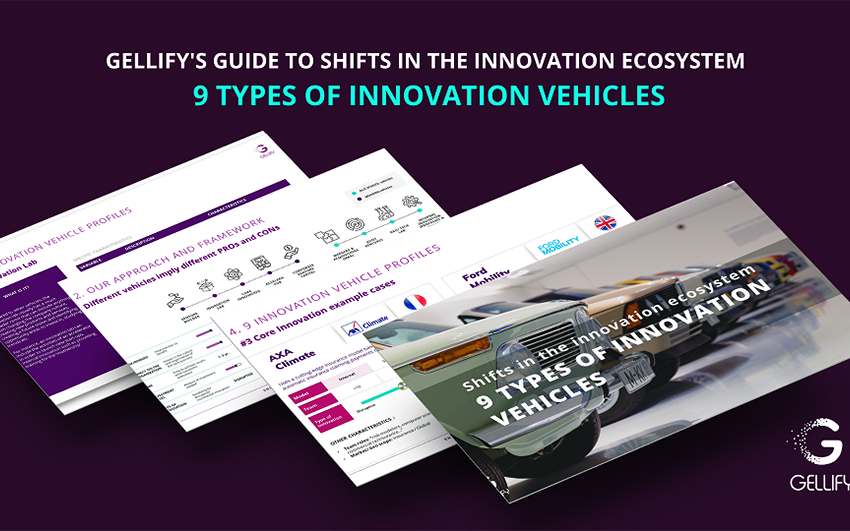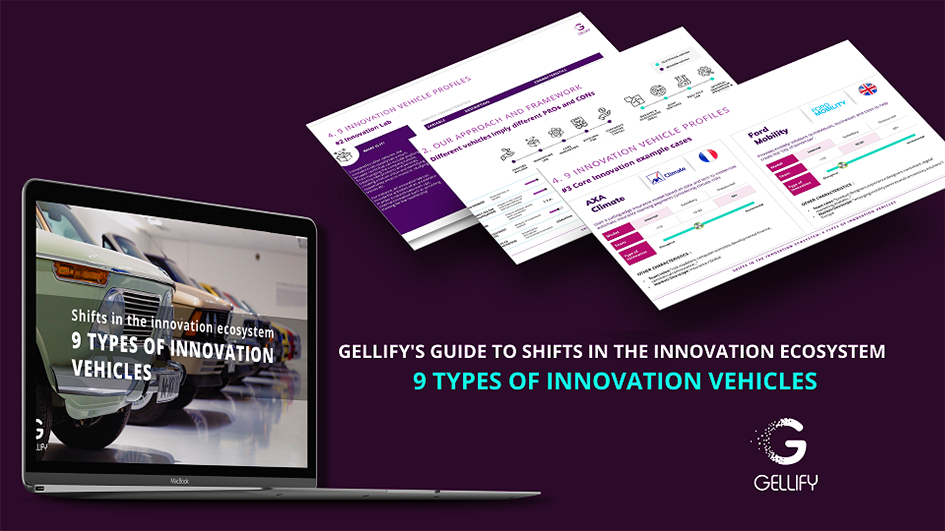GELLIFY releases insightful new report on nine types of innovation vehicles

The report provides valuable insights into the landscape of venture building and innovation.
- GELLIFY, as part of “the purple way to innovation”, introduces the concept of “innovation vehicle” that is missing from the corporate innovation vocabulary
- The analysis shows how the lack of structure to drive innovation is responsible for high failure rates within corporates
- Each of the nine innovation vehicles has its own pros and cons, and choosing the right one is key to successful innovation
- Corporates risks falling into the trap of the four innovation sins in the absence of a well-defined innovation vehicle
Dubai, UAE, December 8, 2022
GELLIFY – a global innovation factory that integrates strategy, design & technology in supporting companies’ growth from vision to execution in a “purple way”- has released a path-breaking report on venture-building “9 TYPES OF CORPORATE INNOVATION VEHICLES: HOW TO DRIVE INNOVATION”.
Innovation practitioners are familiar with the concepts of innovation labs, R&D centres, corporate VC, Venture builders, etc. Although these all work in different ways, they have one thing in common: they all are organizational structures with the aim of driving innovation. However, the “innovation vocabulary” is still missing a word that brings all of these under a single umbrella label. GELLIFY aims to change that by popularizing the term “innovation vehicles”.
The newly released report also provides a comparative insight into the venture-building and innovation landscape of the 90s and today, illustrating how corporates’ legacy approach to innovation worked in stable environments versus what types of “innovation vehicles” are needed by the corporates to thrive today.


According to Statista, the S&P 500 companies’ lifespan in the 80s was over 40 years which meant less pressure to innovate and traditional methods of innovation – which GELLIFY classified as four – “old school vehicles” typically comprised of M&As, joint ventures, R&D/tech labs, and internal innovation (processes & tools) were enough to keep up with the competition.
While today, corporates do operate and adapt to markets with low entry barriers, fast-changing technologies, and more customer power, they also need to adopt faster and more agile ways to innovate via what GELLIFY terms ‘modern innovation’ vehicles in order to avoid being disrupted, especially as the average age of a company listed on the S&P 500 has now fallen to less than 20 years.
“20 years ago, innovation was mainly an R&D game in scientific fields, businesses were changing by a very rational re-engineering process, often driven by the intent to adopt existing best practices in years’ time. Today, innovation is a creative exercise that has become a continuous process of inventing new ways of working and disruptive business models, to beat the competitors in months!” – says Massimo Cannizzo, CEO & Co-Founder at GELLIFY Middle East.
This can be enabled by setting up “new” innovation vehicles, what GELLIFY classifies as “organizational entities that manage and execute different types of innovation with purpose and structure”, as the old vehicles already have a more defined structure, while for the new ones, this does not always happen. This will allow corporate innovation to be focused, clear, repeatable, and measurable.

Each innovation vehicle is a permanent unit (e.g., it is not a project or task force) and has a specific set of objectives, a dedicated team, funding, etc. An innovation vehicle goes through a process where each characteristic of the vehicle is carefully designed, depending on several factors, such as resources, existing culture, and corporate objectives. These entities can be more or less tied to the core business ‘mothership’: in terms of culture, physical location, funding, legal structure, etc.
Without a well-defined innovation vehicle, a corporate entity risks falling into the trap of the 4 innovation sins and of the ‘innovation theater’, namely: lack of structure, lack of strategy and purpose, poor execution, and lack of innovation culture.
Most importantly, we must not forget that corporate Innovation is a journey. The destination of the company, goals, path, pace, background etc. could suggest different vehicles for different journeys. Creating an innovation vehicle that is efficient and perfectly suits the needs of the corporate is not immediate and does not have to be the “Rolls-Royce”, but building & launching a vehicle quickly and refining it over time is the right approach to success.
Commenting on GELLIFY’s approach and framework regarding innovation vehicles, Enrique Ortega, Managing Director and Business Innovation Consulting Lead at GELLIFY Middle East, said: “Like it happens with cars, no innovation vehicle is objectively better or worse than another. It all depends on what you need the vehicle for. You might have a very fancy and powerful car, but if you live in the city center of a historic town with narrow streets, you will not get very far. Innovation vehicles need an even more tailored approach to match perfectly with the Culture and the Business model of each Company.
The complete report providing an in-depth understanding of how to manage and execute different types of innovation with purpose and structure can be downloaded here.








